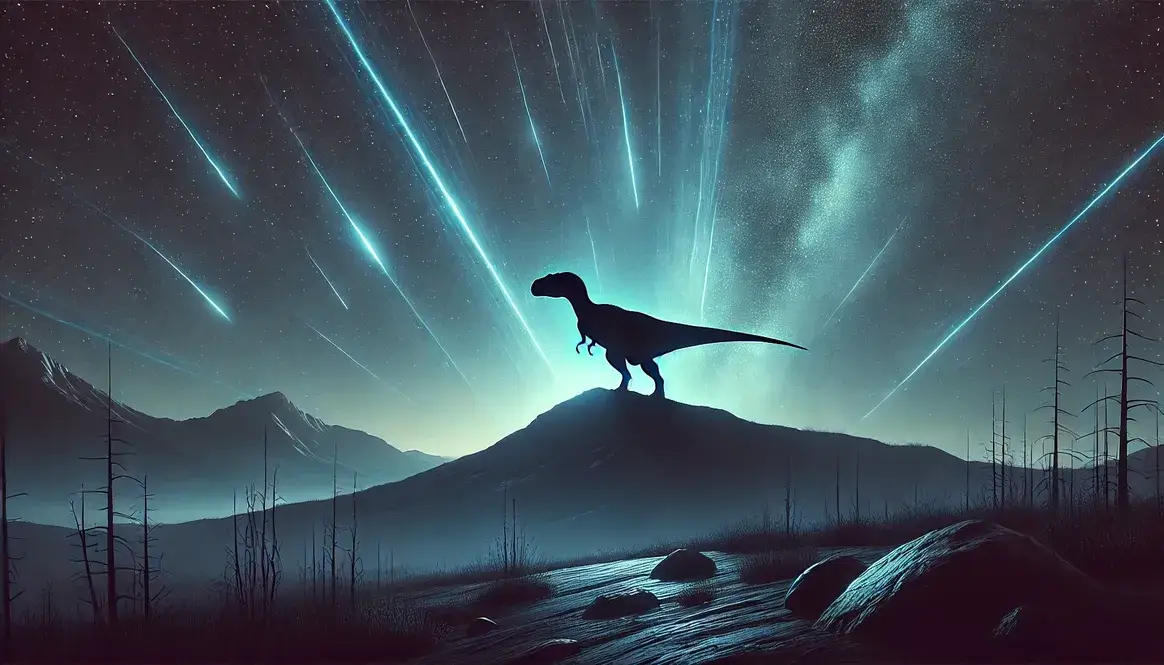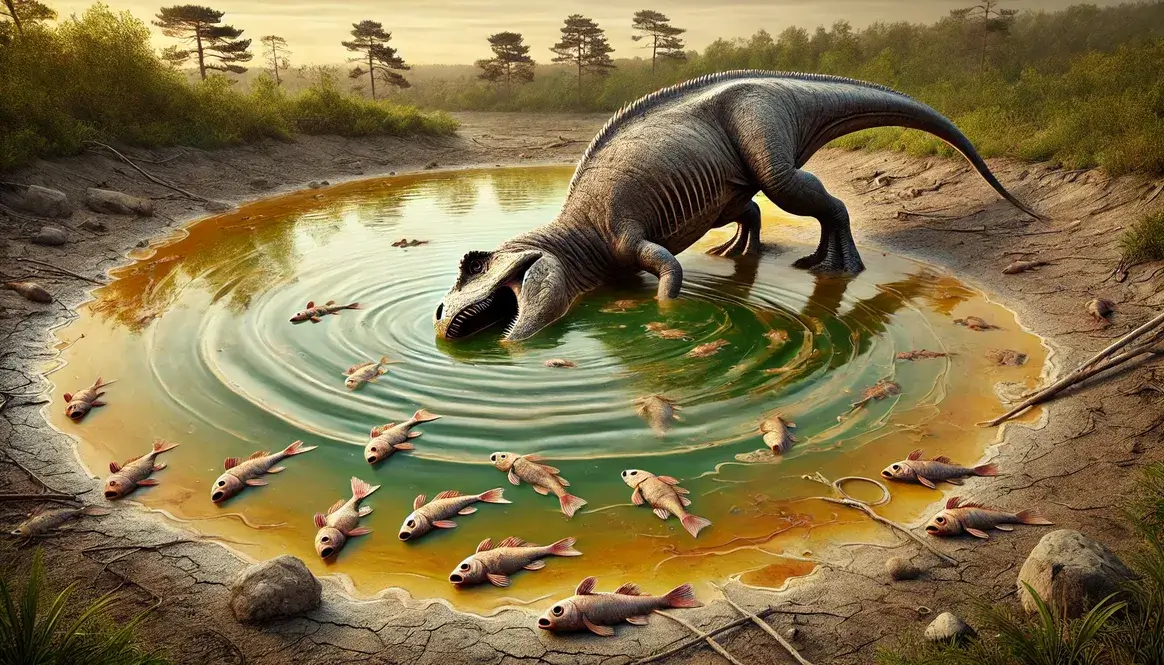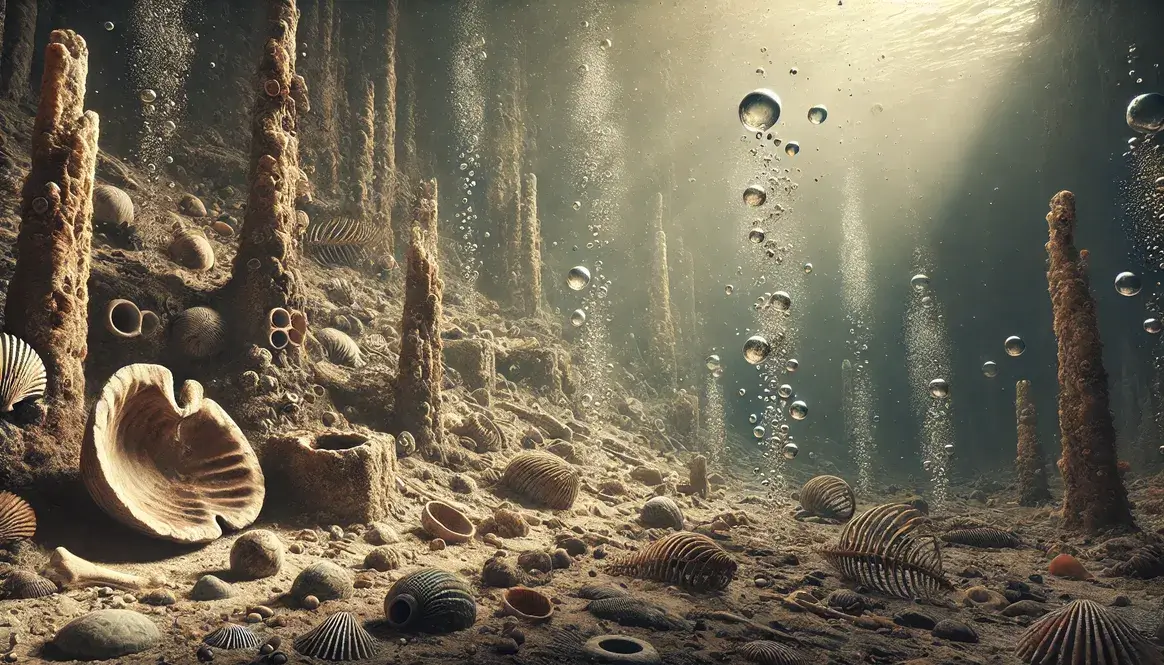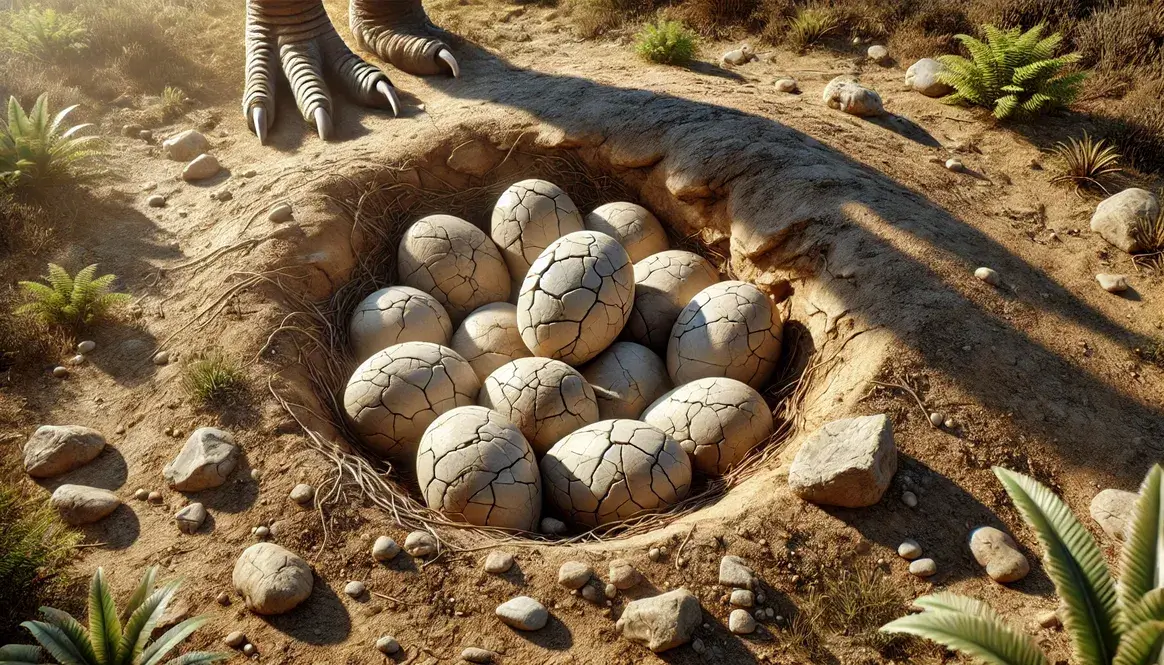Scientists have proposed many explanations for why dinosaurs went extinct 66 million years ago. While most research points to an asteroid impact, some scientists think cosmic rays – powerful radiation from space – might have contributed to the mass extinction that wiped out most dinosaurs.
| Key Question | Scientific Answer |
|---|---|
| Could cosmic rays have killed dinosaurs? | Scientists think cosmic rays alone probably didn’t cause dinosaur extinction, but they might have played a supporting role |
| What are cosmic rays? | High-energy particles from space that can damage living things |
| When was this theory proposed? | 1950s, with renewed interest in the 1990s |
| Main evidence for the theory | Changes in Earth’s magnetic field and nearby stellar events could have increased radiation |
| Main evidence against | No clear geological signs of massive cosmic ray exposure at extinction time |
What Scientists Know About the Dinosaur Extinction
Most scientists agree that a massive asteroid struck Earth near what is now Mexico’s Yucatan Peninsula. The impact created the Chicxulub crater and triggered a chain of events that led to global climate changes. However, some researchers suggest other factors might have worked together with the asteroid impact to cause such widespread extinction.
The effects of this asteroid impact were severe:
- Dust and debris blocked sunlight
- Temperatures dropped worldwide
- Plant growth slowed or stopped
- Food chains broke down
- Many species died out
But some scientists wonder if something else weakened life on Earth before the asteroid hit. This brings us to an interesting question: could cosmic rays from space have made Earth’s creatures more vulnerable to extinction?
Think of it like this: If you’re already sick when you get injured, it’s harder to recover. Similarly, if cosmic rays had already damaged Earth’s environment, the asteroid impact might have been even more devastating than it would have been on its own.
Scientists study extinction patterns by examining fossils and rocks from this time period. They’ve found that some species started declining before the asteroid impact, which suggests other factors might have been at work. This observation led some researchers to consider whether cosmic rays might have played a part in these early declines.
Could Cosmic Rays Have Killed Dinosaurs?
The idea that cosmic rays might have contributed to dinosaur extinction first emerged when scientists discovered these powerful particles could damage living things. But what exactly are cosmic rays? They’re not actually rays at all – they’re tiny particles moving through space at incredibly high speeds.
Think of cosmic rays like microscopic bullets from space. When they hit Earth, they can pass through almost anything, including living tissue. Just as exposure to too much regular radiation can make you sick, large amounts of cosmic rays can harm or kill living things.
| Effects of Cosmic Rays | Impact on Life |
|---|---|
| DNA damage | Can cause mutations and affect reproduction |
| Radiation sickness | Makes organisms weak and more likely to get sick |
| Cell death | Can kill living tissue |
| Atmospheric changes | Affects cloud formation and climate |
Scientists who study dinosaur extinction patterns noticed something interesting: some groups of dinosaurs seemed to be struggling before the famous asteroid struck Earth. This observation made them wonder if increased cosmic ray exposure might have weakened these ancient animals.
The connection between cosmic rays and extinction became more intriguing when researchers found evidence that Earth’s magnetic field changed dramatically during the late Cretaceous period. Earth’s magnetic field usually protects us from cosmic rays, like an invisible shield. If this shield weakened millions of years ago, more cosmic rays would have reached Earth’s surface.
Signs that cosmic rays might have affected dinosaurs include:
- Changes in fossil patterns
- Evidence of magnetic field fluctuations
- Traces of radiation in rocks
- Signs of environmental stress in plants
But there’s a catch – finding direct proof of ancient cosmic ray damage isn’t easy. Unlike the clear evidence of asteroid impact, cosmic ray effects don’t leave obvious marks in the fossil record. This makes it harder for scientists to prove or disprove this theory.
The cosmic ray theory reminds us that Earth’s history is complex, with many factors potentially working together to shape life’s story. While cosmic rays alone probably didn’t cause dinosaur extinction, they might have been one piece of a larger puzzle.
Where Deadly Cosmic Rays Come From
Cosmic rays don’t just come from one place – they arrive from various sources throughout space. Understanding where these rays originate helps scientists evaluate whether they could have played a role in dinosaur extinction.
Supernova Explosions
The most powerful cosmic rays come from exploding stars called supernovas. When a massive star explodes, it releases an enormous burst of energy and particles. If a supernova occurred close enough to Earth during the late dinosaur period, it could have bombarded our planet with deadly radiation.
| Distance from Earth | Effects of Supernova |
|---|---|
| Less than 50 light-years | Severe damage to life |
| 50-100 light-years | Moderate radiation increase |
| More than 100 light-years | Minor to no effect |
Earth’s Magnetic Shield
Earth’s magnetic field usually protects us from cosmic rays, but this shield isn’t always equally strong. Scientists have found evidence that the magnetic field sometimes weakens or even reverses direction. During these changes, more cosmic rays can reach Earth’s surface.
When the magnetic field weakens:
- More radiation reaches the ground
- The atmosphere becomes less protected
- Life faces greater exposure to cosmic rays
- Environmental changes can occur
Dense Space Clouds
Sometimes our solar system passes through dense clouds of gas and dust in space. These clouds can affect how many cosmic rays reach Earth in two ways:
- They contain their own sources of cosmic rays
- They can modify our magnetic field’s strength
The effects might seem small at first, but over thousands of years, they could create major changes in Earth’s environment and atmosphere.
Galactic Movement
Our solar system doesn’t stay still – it moves through different parts of the Milky Way galaxy. Some areas of the galaxy have more cosmic rays than others. Scientists think Earth might have passed through a particularly radiation-rich region around the time of dinosaur extinction.
All these sources working together could have created what scientists call a “perfect storm” of cosmic ray exposure. While one source alone might not cause major problems, multiple sources increasing cosmic rays at the same time could have serious effects on life.
How Cosmic Rays Affect Living Things
When scientists study whether cosmic rays could have harmed dinosaurs, they look at how this radiation affects living things today. This helps them understand what might have happened millions of years ago.
Direct Effects on DNA
DNA contains the instructions for life, like a very detailed recipe book. Cosmic rays can damage these instructions in several ways. Think of it like tiny scissors cutting up the pages of that recipe book – the instructions get mixed up or destroyed.
| Type of DNA Damage | Effect on Organisms |
|---|---|
| Base pair changes | Creates mutations that can be passed to offspring |
| Strand breaks | Kills cells or causes them to function incorrectly |
| Chromosome damage | Affects growth and development |
| Gene deletions | Removes important genetic information |
When dinosaur reproduction patterns changed, it could have seriously affected their survival. High levels of cosmic rays might have:
- Increased mutation rates
- Made it harder for eggs to develop normally
- Caused birth defects
- Led to fewer successful hatchings
- Damaged reproductive cells
- Reduced fertility
- Created problems with egg production
- Affected parent dinosaurs’ ability to care for young
Scientists studying modern animals exposed to radiation have seen similar problems. For example, birds – which are related to dinosaurs – are particularly sensitive to radiation damage. This suggests their dinosaur ancestors might have been vulnerable too.
The effects of DNA damage can build up over time. While one exposure might not cause major problems, repeated exposure across many generations could weaken entire species. This might explain why some dinosaur groups declined before the final extinction event.
Research shows that larger animals often suffer more from radiation effects than smaller ones. Since many dinosaurs were very large, they might have been especially vulnerable to cosmic ray damage.
Changes to Earth’s Atmosphere
Cosmic rays don’t just affect living things directly – they can change Earth’s entire atmosphere. When cosmic rays hit air molecules, they create a chain reaction that affects weather and climate.
Here’s what happens when cosmic rays enter our atmosphere:
Step 1: Ionization
- Cosmic rays split air molecules apart
- This creates electrically charged particles
- These particles change how clouds form
Step 2: Cloud Formation The charged particles act like tiny magnets, attracting water vapor. This process:
- Makes more clouds form
- Creates different types of clouds
- Changes where clouds appear in the sky
Step 3: Temperature Effects
| Cloud Change | Temperature Effect |
|---|---|
| More low clouds | Cooling of Earth’s surface |
| More high clouds | Warming of atmosphere |
| Changed cloud patterns | Disrupted weather systems |
These atmospheric changes could have created serious problems for dinosaurs. When toxic substances accumulated in the atmosphere, many plants and animals struggled to survive. The combination of altered temperatures and unusual weather patterns might have:
- Changed rainfall patterns
- Created longer cold or hot periods
- Affected plant growth seasons
- Disrupted migration patterns
Scientists studying this theory believe these atmospheric changes could have lasted for thousands of years. If cosmic rays remained strong for long periods, they might have changed Earth’s climate enough to stress dinosaur populations before the final extinction event.
The effects would have been similar to a very long winter, making it harder for both plants and animals to thrive. This matches evidence found in rocks from this time period, which show signs of climate stress and changing weather patterns.
Effects on Plants and Animals
When cosmic rays strike Earth, they affect all living things – from the smallest plants to the largest dinosaurs. Plants suffer first, which starts a chain reaction throughout the entire food web.
Plant Damage Effects:
- Slowed growth rates
- Increased mutation rates
- Reduced seed production
- Weakened immune systems
The damage to plants created big problems for plant-eating dinosaurs, which then affected meat-eating dinosaurs. This pattern resembles how early mammals gained advantage over dinosaurs when food sources changed.
| Food Chain Level | Effects of Cosmic Ray Exposure |
|---|---|
| Plants | Reduced growth and reproduction |
| Plant-eaters | Less food available, weaker populations |
| Meat-eaters | Fewer prey animals, increased competition |
| All animals | Weakened immune systems, increased disease |
When plants struggled to grow, the effects rippled through the entire ecosystem. Large plant-eating dinosaurs needed huge amounts of food each day to survive. Even a small reduction in plant growth could have made it hard for them to find enough food.
Multiple problems often work together to make things worse. Just as diseases affected dinosaur survival, cosmic rays might have made it harder for dinosaurs to fight off illness. When animals are:
- Not getting enough food
- Exposed to radiation
- Living in changing climates
- Fighting diseases
They become much more likely to die out than if they only faced one problem at a time.
This combination of stresses helps explain why some scientists think cosmic rays might have played a role in dinosaur extinction, even if they weren’t the main cause. The radiation could have made dinosaurs more vulnerable to other challenges, like climate change or the asteroid impact.
Evidence For and Against the Theory
Scientists look for many different kinds of evidence when studying whether cosmic rays could have contributed to dinosaur extinction. Let’s examine the clues that support this idea.
Supporting Evidence
Geological Evidence Scientists have found interesting patterns in rocks from the time dinosaurs went extinct. These rocks contain:
| Evidence Type | What It Shows |
|---|---|
| Magnetic minerals | Changes in Earth’s magnetic field |
| Isotope variations | Increased radiation exposure |
| Carbon changes | Atmospheric disturbances |
Historical Patterns Earth has experienced periods of increased cosmic ray exposure before. By studying these events, scientists have found that increased radiation often matches times when many species died out. Signs of these events include:
- Layers of unusual minerals in rocks
- Changes in fossil patterns
- Evidence of climate changes
The fossil record tells an interesting story too. Just as methane affected ancient environments, cosmic rays might have changed Earth’s atmosphere in ways that left marks in the rocks. Scientists have found:
- Unusual patterns in plant fossils
- Sudden changes in plant types
- Evidence of radiation damage
- Signs of climate stress
- Animal fossil changes
- Declining populations over time
- Changes in species distribution
- Evidence of genetic stress
- Environmental indicators
- Shifts in mineral formation
- Changes in sediment patterns
- Signs of atmospheric changes
These clues suggest Earth experienced significant environmental changes before the asteroid impact. The patterns match what scientists would expect to see if cosmic rays had increased during this time.
Some scientists point out that these changes happened gradually, which fits with the idea of increasing cosmic ray exposure over thousands of years. This slow change might explain why some dinosaur groups started declining before the final extinction event.
Scientific Challenges
While some evidence supports the cosmic ray theory, scientists have found several problems with it. These challenges make it hard to prove that cosmic rays played a major role in dinosaur extinction.
Timing Problems Finding the exact time when cosmic rays might have increased is difficult. Scientists need to match increased radiation with dinosaur extinction times, but the evidence isn’t clear. It’s like trying to solve a puzzle with missing pieces.
| Challenge | Why It Matters |
|---|---|
| Dating uncertainty | Can’t prove cosmic rays increased at the right time |
| Incomplete records | Missing evidence from many locations |
| Mixed signals | Other events mask radiation evidence |
Questions About Radiation Levels Even if cosmic rays did increase, scientists debate whether the levels were high enough to cause serious problems. They consider several factors:
- Natural radiation resistance
- Many animals can handle some radiation
- Plants often survive radiation exposure
- Some species might have adapted
- Protection from the environment
- Water blocks radiation
- Soil provides shielding
- Deep forests offer protection
Other Explanations Many scientists think other factors better explain the extinction. They point to:
- The proven asteroid impact
- Global climate changes
- Volcanic activity
- Combined effects of multiple causes
The asteroid impact left clear evidence that we can still see today. In contrast, proving that cosmic rays harmed dinosaurs requires more guesswork. While cosmic rays might have added to the problems dinosaurs faced, most scientists think they weren’t the main cause of extinction.
Think of it this way: if you have a clear photo of someone breaking a window (like our evidence for the asteroid impact), it’s more convincing than hearing that someone might have weakened the glass earlier (like our evidence for cosmic rays).
The debate continues as new research provides more information. Scientists keep studying rocks, fossils, and other evidence to better understand what really caused dinosaurs to go extinct.
Modern Research Methods
Scientists today use advanced technology to study whether cosmic rays might have affected dinosaurs. These tools help them look for clues that would have been impossible to find just a few years ago.
Main Research Tools:
| Tool | What It Studies |
|---|---|
| Mass spectrometers | Measure radiation traces in rocks |
| Computer models | Simulate ancient cosmic ray effects |
| Particle detectors | Test how radiation affects living things |
| Satellite data | Track current cosmic ray patterns |
Scientists also examine tiny crystals in rocks that act like ancient radiation detectors. These crystals trap evidence of past radiation exposure, similar to how a camera captures light. By studying these crystals, researchers can estimate how much radiation reached Earth millions of years ago.
Recent discoveries have shown that:
- Earth’s magnetic field changes more often than we thought
- Nearby stars could have affected Earth more than expected
- Some rocks contain unexpected patterns of radiation damage
Laboratory experiments help scientists understand how radiation affects different materials. They can:
- Test radiation effects on modern plants
- Study how minerals react to cosmic rays
- Measure DNA damage from different radiation types
What This Means for Dinosaur Extinction
While cosmic rays probably didn’t cause dinosaur extinction by themselves, new research suggests they might have played a small part in the story. Just as scientists study how ancient oxygen levels changed, they continue investigating the possible effects of cosmic rays.
The mystery of dinosaur extinction reminds us that big changes in Earth’s history often have many causes working together. Scientists keep searching for new clues, using better tools and methods to understand what really happened to these amazing animals.
Future research might reveal more about how cosmic rays affected life in the past. Until then, the cosmic ray theory remains an interesting possibility in the complex story of dinosaur extinction.









